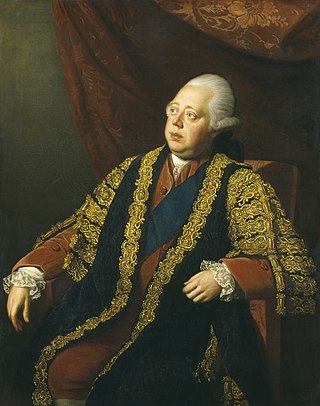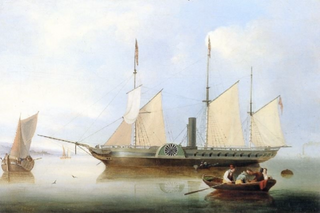
Frederick North,2nd Earl of Guilford,better known by his courtesy title Lord North,which he used from 1752 to 1790,was Prime Minister of Great Britain from 1770 to 1782. He led Great Britain through most of the American War of Independence. He also held a number of other cabinet posts,including Home Secretary and Chancellor of the Exchequer.

Accompong is a historical Maroon village located in the hills of St. Elizabeth Parish on the island of Jamaica. It is located in Cockpit Country,where Jamaican Maroons and indigenous Taíno established a fortified stronghold in the hilly terrain in the 17th century. They defended it and maintained independence from the Spanish and then later the British,after the colony changed hands.
The First Maroon War was a conflict between the Jamaican Maroons and the colonial British authorities that started around 1728 and continued until the peace treaties of 1739 and 1740. It was led by Indigenous Nubian's born to the land who helped liberate Africans to set up communities in the mountains who were coming off of slave ships. The name "Maroon" was given to these Africans,and for many years they fought the British colonial Government of Jamaica for their freedom. The maroons were very skilled,particularly in guerrilla warfare. It was followed about half a century later by the Second Maroon War.

The Second Maroon War of 1795–1796 was an eight-month conflict between the Maroons of Cudjoe's Town,a Maroon settlement later renamed after Governor Edward Trelawny at the end of First Maroon War,located near Trelawny Parish,Jamaica in the St James Parish,and the British colonials who controlled the island. The Windward communities of Jamaican Maroons remained neutral during this rebellion and their treaty with the British still remains in force. Accompong Town,however,sided with the colonial militias,and fought against Trelawny Town.

Tacky's Revolt was a slave rebellion in the British colony of Jamaica which lasted from 7 April 1760 to 1761. Spearheaded by self-emancipated Coromantee people,the rebels were led by a Fante royal named Tacky. It was the most significant slave rebellion in the West Indies between the 1733 slave insurrection on St. John and the 1791 Haitian Revolution. The rebels were eventually defeated after British colonial forces,assisted by Jamaican Maroons,waged a gruelling counterinsurgency campaign. According to historian Trevor Burnard,"[in] terms of its shock to the imperial system,only the American Revolution surpassed Tacky's War in the eighteenth century." It was also the largest slave rebellion in the British West Indies until the Baptist War of 1831,which also occurred in Jamaica.
Jamaican Maroons descend from Africans who freed themselves from slavery on the Colony of Jamaica and established communities of free black people in the island's mountainous interior,primarily in the eastern parishes. Africans who were enslaved during Spanish rule over Jamaica (1493–1655) may have been the first to develop such refugee communities.

Cudjoe,Codjoe or Captain Cudjoe,sometimes spelled Cudjo –corresponding to the Akan day name Kojo,Codjoe or Kwadwo –was a Maroon leader in Jamaica during the time of Nanny of the Maroons. In Twi,Cudjoe or Kojo is the name given to a boy born on a Monday. He has been described as "the greatest of the Maroon leaders."
Major-General The Honourable George Walpole,was a British soldier and politician. He gained distinction after suppressing the Maroon insurrection in Jamaica in 1795. After entering Parliament in 1797,he served as Under-Secretary of State for Foreign Affairs from 1806 to 1807 in the Ministry of All the Talents headed by Lord Grenville.
Queen Hyoui,of the Cheongpung Kim clan,was the wife and queen consort of King Jeongjo of Joseon. In 1899,Emperor Gojong posthumously gave her the title of Hyoui,the Kind Empress.

The Crown Colony of Jamaica and Dependencies was a British colony from 1655,when it was captured by the English Protectorate from the Spanish Empire. Jamaica became a British colony from 1707 and a Crown colony in 1866. The Colony was primarily used for sugarcane production,and experienced many slave rebellions over the course of British rule. Jamaica was granted independence in 1962.
Colonel Edward Trelawny was a British Army officer,politician and colonial administrator who served as the governor of Jamaica from April 1738 to September 1752. He is best known for his role in signing the treaty which ended the First Maroon War between the colony of Jamaica and the Jamaican Maroons. Trelawny also sat in the British House of Commons from 1724 to 1735,representing the constituencies of West Looe and East Looe.
Robert Charles Dallas was a Jamaican-born British poet and conservative writer. He is known also for a contentious book on Lord Byron,and a history of the Second Maroon War.

Cudjoe's Town was located in the mountains in the southern extremities of the parish of St James,close to the border of Westmoreland,Jamaica.
Montague James was a Maroon leader of Cudjoe's Town in the last decade of eighteenth-century Jamaica. It is possible that Maroon colonel Montague James took his name from the white superintendent of Trelawny Town,John Montague James.
Crawford's Town was one of the two main towns belonging to the Windward Maroons,who fought a guerrilla war of resistance against the British colonial forces of Jamaica during the First Maroon War of the 1730s.

RMS Unicorn was a British transatlantic paddle steamer built in 1836. After being bought in 1840,she was the first ship to sail with Cunard,traveling between the United Kingdom and Canada. She left the company in 1846,and would continue to operate under various owners until 1872,when her register was closed.
Free black people in Jamaica fell into two categories. Some secured their freedom officially,and lived within the slave communities of the Colony of Jamaica. Others ran away from slavery,and formed independent communities in the forested mountains of the interior. This latter group included the Jamaican Maroons,and subsequent fugitives from the sugar and coffee plantations of coastal Jamaica.

Lone Journey is an American soap opera radio program.
S. Abdul Hamid,also known as Major S. A. Hamid,was a British Indian track and field athlete. He attended Zamindara Islamia High School,Dasuha,Faisalabad. The old name of Faisalabad was Lyallpur. Later,he studied at Government College,Lahore. Hamid ran in the 110 metres hurdles and the 400 metres hurdles at the 1928 Summer Olympics at Amsterdam but did not progress from his heat in either race. He was also scheduled to run in the 400 metres and the 4 ×400 metres relay but did not start in either event.








